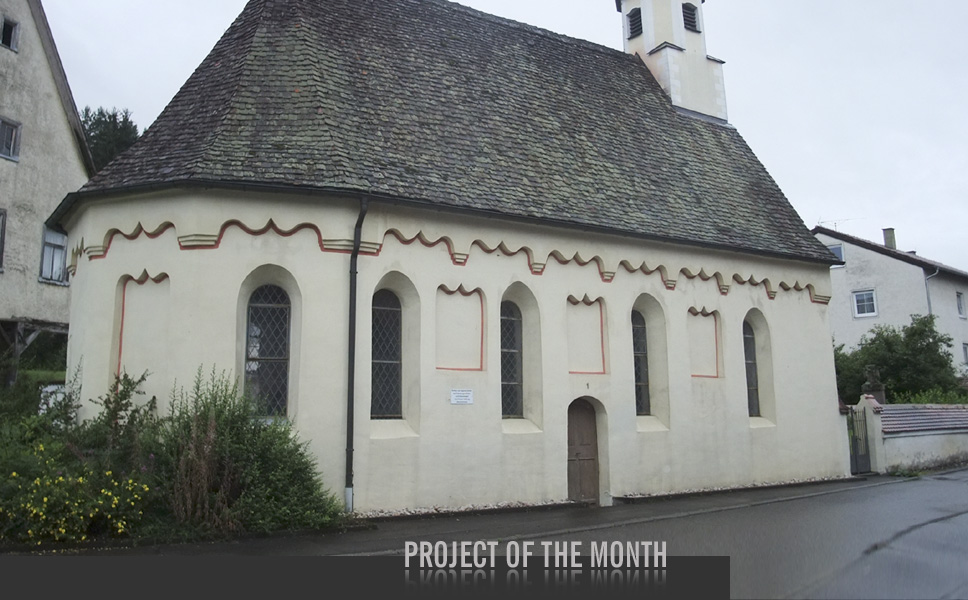|
The chapel in 1983, one year before the restoration
|
 |
| Today, the chapel is still in perfect condition |
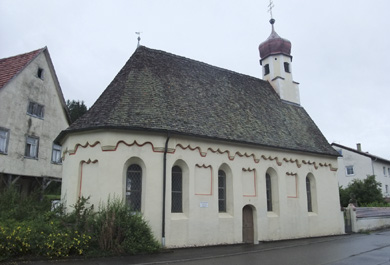 |
|
Close-up of the base area
|
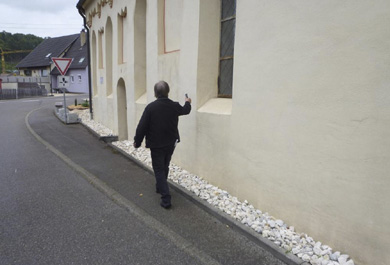 |
|
View of the chapel with steeple and pediment
|
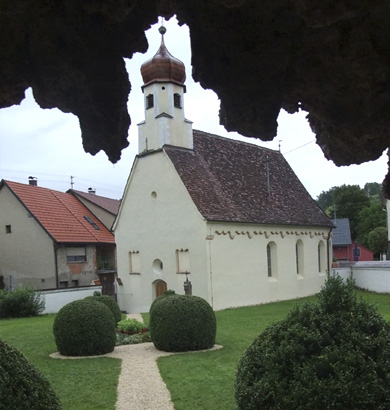 |
Fotos: Architekt Hans-Peter
Wallisch
|
| |
|
| |
|
| |
| |
|
| |
|
| |
| |
|
|
Rehabilitating masonry:
local visit after some 30 years
 In 1984, the base of the Chapel of Our Lady, built in
In 1984, the base of the Chapel of Our Lady, built in
1591 in the Swabian town of Neufra, was restored with epasit renovation plaster, and it is still in perfect condition almost 30 years later. The Neufra architect Hans-Peter Wallisch documented the restoration at the time; examinations by Ernst Lorch Restaurator GmbH (Sigmaringen) in 1983 provide further evidence.
In 1984, the architect Hans-Peter Wallisch from Neufra supervised the rehabilitation and remembers: 'After the application of renovation plaster, undermined areas often reappear quickly. The Chapel of Our Lady, however, is in a good state even 30 years after the restoration with epasit renovation plaster.' Snapshots taken by him in 1983 show serious salt deposits, especially in the base area. In the course of the centuries, moisture and environmental influences had affected the building.
1984: restoration of the masonry step by step

In 1984, the Chapel's 2.50 m high base area was restored by the Dietmann building company from Neufra. To do so, the masons knocked off the salt-damaged old plaster down to the masonry and scratched loose mortar out of the masonry joints. Subsequently, the masons cleaned the surface with a steel brush and compressed air. A grid of 320 kg of epasit bonding coarse plaster hb was applied to the base area. In the next step, large uneven areas were evened with approx. 400 kg of epasit ap levelling plaster. Then, various layers of lpf epasit renovation plaster were applied. 1,200 kg of this material were necessary to give the base an even plaster surface and to adapt it to the old plaster above the base.
Make-up for the facade

After the renovation plaster system had dried out the Chapel's facade was painted - also in 1984 - by the Daikeler painting company from Neufra, using a two-component silicate paint. Additionally, the steeple and the pediment were given a water repellent finish. Since then, almost 30 years have passed without a new coat being necessary, let alone a restoration.
Documented history of the Chapel

According to history books, the Chapel of Our Lady, popularly known as 'Mother of God's Chapel' was built after 1591 on the orders of Reichsfreiherr Schad from Mittelbiberach and his wife Margarethe. Its architect Hans Kutzberger came from Biberach. The 16 m long and almost eight metre wide chapel is constructed of a mixed masonry, mainly of brick, tufo and undressed stone. To get the right historic colouring when renovating it, a restorer was commissioned with the building research in 1983. In his report he states that the external plaster and painted decorations from 1591 are still present to a large extent. This meant a 12 mm thick, single-layer, bright yellow air-hardening lime mortar with an even surface. At the base there were defective spots all round .
Permanently, systematically restored

As early as the beginning of the 1970s the epasit renovation plaster system MineralSano Pro® was developed by epasit and sold as Sanierputzsystem 2000. It is suitable for the restoration of damp walls affected by salt, by absorbing salts which are damaging the building material and thus leading the way for disintegration. With a high pore volume, a low absorbency and a good water vapour permeability it encourages the masonry to dry out naturally. The renovation plaster system meets all architectural conservation requirements and is in line with DIN EN 998-1 and the WTA (Wissenschaftlich-Technische Arbeitsgemeinschaft für Bauwerkserhaltung und Denkmalpflege).
epasit: Solutions for building
materials from a single source.

For more than 50 years, the epasit GmbH develops and produces special building materials for rehabilitation, renovation and modernization. The product range comprises, among other things, the waterproofing of buildings, the rehabilitation of monuments and old buildings as well as the rehabilitation of damages caused by mould and moisture. Drinking water tanks or swimming pools, too, are rehabilitated with products from epasit. With sought after inventions for building protection and building rehabilitation, the family company distinguishes itself as a think tank. In addition to thousandfold proved standard products, epasit develops individual solution for its customers.
Presscontact:
 epasit GmbH Spezialbaustoffe
epasit GmbH Spezialbaustoffe
Peggy Wandel
Sandweg 12 - 14, D-72119 Ammerbuch-Altingen,
Tel +49 (0) 7032 2015-0, Fax +49 (0) 7032 2015-21
e-Mail: presse@epasit.de
|
|
|

Contact
us

Do you have questions and need
a personal contact?
Phone
+49 (0)7032
- 20 15-0
Project management

Walter Bajcar
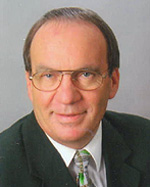
If you have further questions regarding this object or a similar
problem, please contact us.
Contact us

e-Mail: walter.bajcar@epasit.de
Phone:
+49 (0)7473 - 270 1087
|
|
